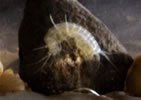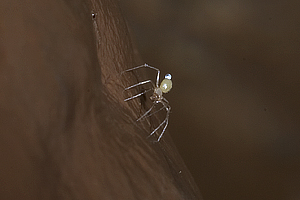 |
Cave Life of Wales |
 |
| |
| HOME |
| INTRODUCTION |
| LIFE IN THE ENTRANCE |
| LIFE IN THE CAVE |
| CONSERVATION |
| GLOSSARY |
| ACKNOWLEDGEMENTS |
| |
| Cave Climate |
| Adaptations |
Introduction - Adaptations |
Outside the cave there are plenty of green plants growing in the sunlight, and feeding on these are herbivores, that are eaten by carnivores; when any of these die they are consumed by detritivores or decomposed by micro-organisms. All these lead to a large and complicated food web. Inside the cave the lack of green plants results in the absence of a a big chunk of this food web. Micro-organisms in the cave use different metabolic pathways that do not need light for photosynthesis – these organisms are crucial for the basis of the food chains in caves. Creatures that have spent generations in the dark show genetic modifications compared with the relatives on the surface. This may be due to mutations that occur naturally such as eye defects; outside the creature would be at a disadvantage but in the dark cave environment it makes no difference. Mutations that involve lack of pigment for camouflage would similarly not be a handicap for the cave dweller. Natural selection will mean any mutations that are useful such as longer antennae or lower metabolic rate may increase in the cave dweller, but it will not preserve characteristics that are important outside but of no use in the cave. Eyes are useless and so become vestigial or absent. Touch also becomes more important so some have longer legs and feelers than their outside equivalents. Conserving energy is important when food is scarce and many organisms have a lower metabolic rate that in some cases leads to a long life expectancy. Many lose their camouflage pigments and are white, even trout lighten in colour as no camouflage is needed (although this is temporary unlike the true troglobites). Each organism has a preferred habitat where it prefers to live - if you are looking for a specific creature find out about its habits to increase your chances of success. Many will be found near its food source, but away from competitors e.g. the cave shrimp Niphargus struggles to compete for food with its surface dwelling cousin Gammerus pulex and so it survives in a different habitat. Gammerus enter caves along with the surface stream they inhabit - Niphargus will be found deeper underground in the phreatic zone or in gour pools fed by seepage water. The creatures are used to the very high humidity and many do not bat an eyelid (if they have one) at being covered in water during a flood, they just sit it out in a crevice and wait for the water to drop.
|
